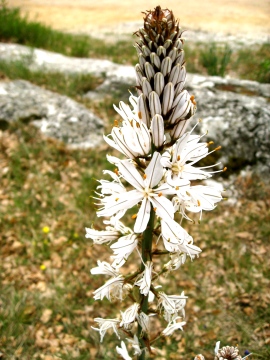Branched Asphodel – Asphodèle
In ancient Greece it was connected with death and the underworld. In Greek mythology, the Elysian fields, final resting place of the souls of the heroic and virtuous, were covered in Asphodel. It was planted near graves as food for the dead.
The plant belongs to the Asphodelaceae family. The sword-like, grey-green leaves are borne in basal tufts up to 50 cm long. The leafless stem (up to 1.6 m) carries a panicle of star-shaped white flowers. Each flower has 6 tepals with a central brown streak. The roots have spindle-shaped tubers. They are edible and should be harvested after the first year.
A strong glue is made from the tubers. They are first dried, then pulverized. When the powder is mixed with cold water it swells and forms a strong glue.
It was considered to be food for the poor. During the second World War, the starchy roots saved many Greeks from hunger. The tubers are bitter, but when boiled they lose their bitterness. The tubers, dried, ground and then boiled in water were mixed with grains or potatoes to make Asphodel bread. The ancients used to roast the roots under embers, they ate them with salt and olive oil. If mixed with figs it was considered a delicacy.
In southern Italy the unopened buds are collected, blanched in boiling water, then preserved in olive oil as a condiment. The young shoots are consumed like wild asparagus. The flowers are edible as well, they have a pleasant flavour.
In Puglia, the south-east coast of Italy, they make a cheese called ‘Burrata’. It is a ball of mozzarella filled with cream and pieces of mozzarella. When cut into, cream oozes out. This cheese is always wrapped in an Asphodel leaf, the reason being that the cheese should be eaten fresh, within 3-4 days of manufacture. Fresh Asphodel leaves means fresh Burrata. When the leaves have dried out it is a sign that the cheese is past its prime.
Omelette made with young asphodel shoots
Ingredients: 1 cup of tender shoots, 3 cm long; 1 small onion, very finely chopped; 2 eggs, lightly beaten, 2 tbsp. cream or evaporated milk; salt and pepper to taste; olive oil for frying.
Make a cut in the asphodel shoots and blanch them in boiling water for 2 minutes. Mix the eggs and milk, beating until well mixed. Fry the shoots with the onion for a few minutes and then pour the egg mixture over them. Cover the pan and cook over a low heat until the eggs are set.
Instead of frying the mixture it can be baked. Cover the bottom of a baking dish with olive oil, sprinkle over the onions and prepared asphodel shoots, other ingredients can be added. Pour over the beaten eggs flavoured with salt and pepper. When the eggs are set and brown the dish is ready. Serve warm.
Bibliography: website – herbs-treatandtaste.blogspot.fr; Docteur Yvan Avramov – Ces précieuses plantes de Méditerranée; Wikipedia – Asphodelus; Marjorie Blamey & Christopher Grey-Wilson – Mediterranean Wild Flowers

